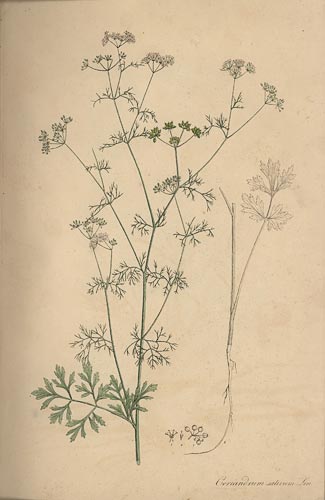Relatives
Coriandrum sativum L. - Coriander.
Taxonomic description.
Family: Apiaceae (Umbelliferae Moris.); genus: Coriandrum L.Morphology and biology.
Annual plant. The whole plant is non-pubescent. Root is thin, fusiform. Stem is straight, orbicular in section, with thin grooves, branchy from the bottom or only in the upper part, 20-70 cm tall. Leaves are light green. Root leaves wither early, set on long stalks, either whole with incised-dentate edges, or tri-lobed, or simply pinnate with orbicular-cuneate dentate leaflets. Lower cauline leaves are bipinnate with a few ovate leaflets, pinnately incised and wedge-shaped at the base. Middle and upper cauline leaves are sessile on oblong sheaths with wide film along the edge, bi- or tripinnatisect, with linear, almost filiform smooth-edged sharp lobules. Umbels with 3-5 bare rays are set on long peduncles. Swathe is absent or consists of one leaflet. Involucels are one-sided, more often with 3 very narrow leaflets. Petals are white or reddish. Outer (unpaired) petal in marginal flowers is 3-4 mm long, bilobate, with oblong lobes; 2 adjacent lateral petals are asymmetrically obovate, bilobate, with the anterior lobe much longer than the posterior one; 2 remaining petals are small, symmetrically obcordate. Inner flowers of the main umbel have slightly emarginate petals. Fruit is globular, 2-5 mm in diameter, brownish yellow or stramineous. Styles are elongated, deflected from one another at an acute angle, with a stigma incrassate at the tip. Blossoms in June-July; bears fruit in August.Distribution.
Worldwide distribution, including Central and Atlantic Europe, the Mediterranean region, the Balkans, Asia Minor, and Iran. Occurs in North and South America as an ecdemic plant. Within the former USSR, this species occurs in the European region (Near-Baltic, Upper-Dnieper, Upper-Volga, Volga-Don, Lower-Don, Volga-Kama and Trans-Volga regions); the Far East (Ussuri region); the Caucasus (Ante-Caucasus and Trans-Caucasus, except the northern part); and Central Asia (Amu-Darya, Syr-Darya, Western Tien Shan and Mountainous Turkmenistan regions).Ecology.
Occurs on dry mountainsides and meadows, more often as a weedy plant in disturbed ecotopes. Occurs near homesteads, along roads, in orchards and in kitchen gardens. Easily grows in the wild.Utilization and economic value.
For food and seasoning. Young shoots are edible (traditionally in the Caucasus under the name of .kinza.) as a spicy herb. Fruit contain essential coriander oil (0.68-0.9%). This oil is used in perfumery, for synthesis of a number of fragrant substances, in the soap industry, liqueur production, and medicine (usually to improve taste and smell of medicaments). Coriander fruit are also utilized to spice confectionary and food products (canned meat). After essential oil distillation, the raw stuff is used for producing fatty oil (up to 18% in fruit). This oil is utilized in soap production and in the textile industry. The cake (meal) remaining after fatty oil production is rich in protein and may be fed to livestock. Green parts of the plant also contain essential oils, but their composition is different from that of the fruit.References:
Cherepanov, S.K., Plantae Vasculares Rossicae et Civitatum Collimitanearum (in limicis USSR olim). St. Petersburg, "Mir I Semia", 1995, 990 p. (in Russian).Grossgheim, A.A. 1967. Flora of Caucasia. Leningrad, Nauka, Vol. VII, 311 p. (in Russian).
Shishkin B.K., ed. 1950. Flora of the USSR. Vol. XVI. M.-L.: Publishing House of the USSR Academy of Sciences, p. 468-469. (in Russian).
Tsvelev, N.N. 2000. Manual of the vascular plants of Northwestern Russia (Leningrad, Pskov and Novgorod district). St. Petersburg, Publishing House of SPHFA, 781 p. (in Russian).


